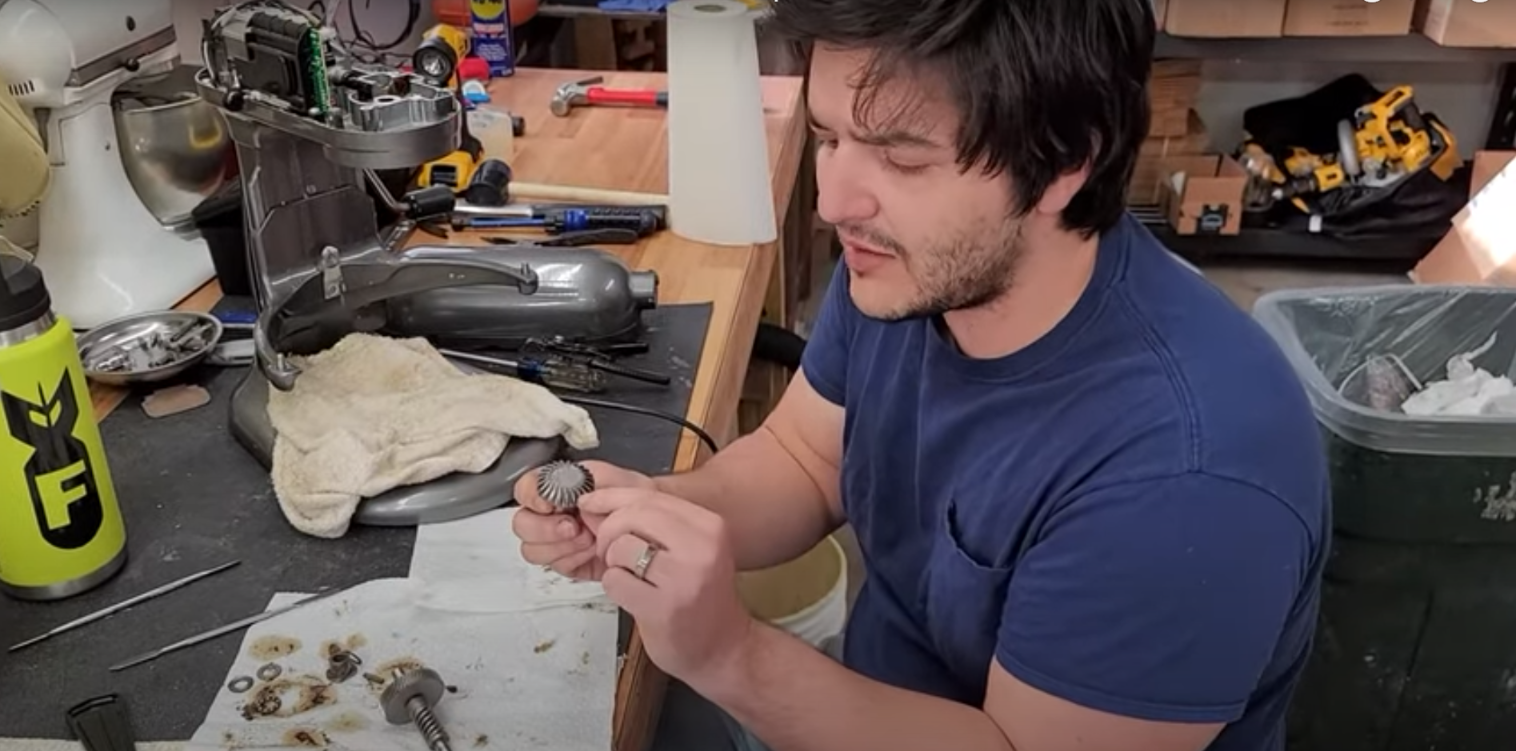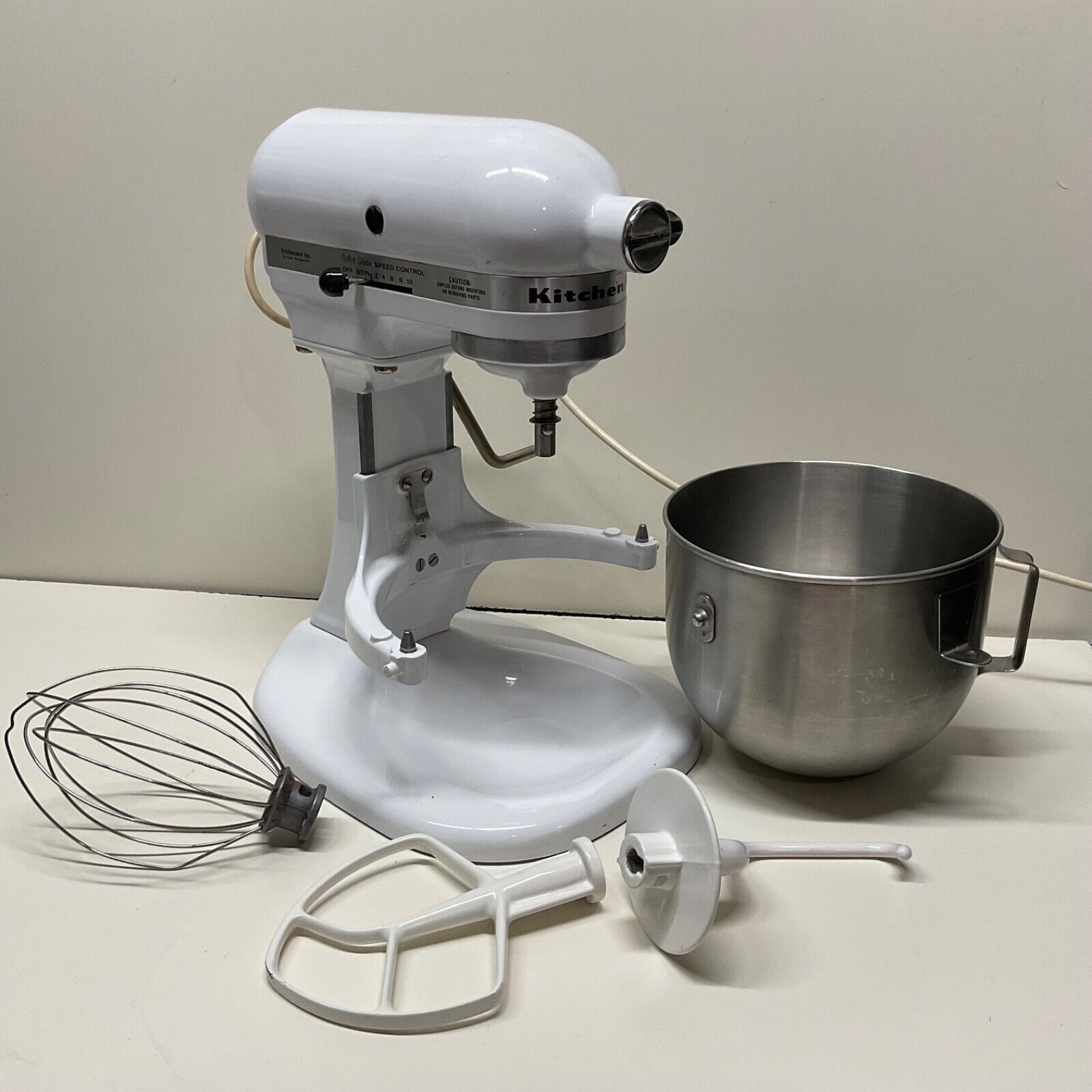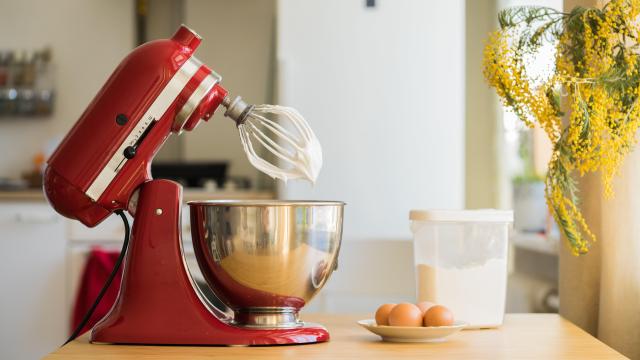I have not named my KitchenAid stand mixer, which is weird when you consider the length of our relationship. My beloved is a model from the 80’s, one of the few things I have that belonged to my parents. While it’s not a fancy newer model in one of the many fantastic colours KitchenAid offers, I refuse to part with it. It’s solid. I figured at some point I’d get it tuned up, or I’d buy a new one if it ever really broke.
While it’s not broken, it does have a tendency to thump against the table as it’s mixing and occasionally walks itself dangerously close to the edge of the counter. It turns out, this is the number one problem with KitchenAid stand mixers. Luckily, a quick, inexpensive adjustment can not only fix the problem entirely, but ensure your mixer works better and prevent future problems.
Enter Mr. Mixer, known in real life as Zach Dinicola. Zach spoke to me from his workshop, where twenty or thirty KitchenAids sat on the shelves, waiting to be tuned up and shipped back to the home bakers eagerly awaiting them. I didn’t search Zach out, appeared to me via the TikTok algorithm, where he encouraged me to take my machine apart on my own for maintenance. And then he kept appearing to me, over and over again, with his free TikTok and YouTube videos that cover how to take apart, service, and fix literally every single aspect of my beloved Kitchenaid, directing me to his website to purchase any part I might need.

How to fix a thumping stand mixer
The part in question for the thumping head is called the Everdime, a $US15 Mr. Mixer invention that, in combination with a screwdriver, will help you adjust the bolt under your tilt head mixer so that the machine stays put, stops dancing around, and ensures the beater of your mixer stays precisely one dime height above the bowl, catching all of your ingredients. (And the directions to do it yourself are free.)
When I spoke to Mr. Mixer, I told him giving people instructions on how to do his job for free was a terrible business plan, but he laughed it off. “We get calls all the time: ‘Hey I’ve never worked on anything in my life, and your videos were so clear it turned out perfect. You made this way too easy.’”
Granted, Zach does more than simple adjustments. These complicated machines heavily benefit from maintenance even when not broken, and people all over the country pay $US50 to ship their heavy KitchenAids to his workshop where his team will tear it apart, replace any broken parts, clean it, tune it up, and ship it back, starting around $US125, and going up based on parts needing replacement. Often, you can watch it all go down on TikTok.
If, like me, you’re still intimidated to try it on your own, Zach reassured me, “I’m not going to let you take your machine apart and ghost you. We email, with pictures, and we answer the phone. Your machine can’t get any more broke. If you get in over your head, we’ll talk you through it or you can ship it in.”
“How many people try it on their own and end up sending the machine in to you anyways?” I asked. “Not as many as you’d think, a very marginal percentage of all the machines that are sent to us,” he said. Mr. Mixer takes in a thousand KitchenAids a year — it’s all they do — so that seemed pretty promising.
Zach is a genial guy, and so we chatted about KitchenAids in a way only real kitchen nerds can.
My editor and I are both convinced that older KitchenAids are just better. Weigh in? Would you buy a new model or try to find an old one?
You want a solid state mixer. The older they are from 2020 back, the better. Even a mixer from 2014-2015 has less plastic parts than they do now. The further you go back, to the 80s and 90s, still solid, so long as it’s after 1978, when KitchenAid switched to the solid state. Even before 1978, those pre-solid state models, they lasted a long time. The problem is, since they haven’t made those old school electronics [since then], they’re getting harder and harder to source parts for.
What are the three things I should be doing to my KitchenAid, whether its been on my shelf for a while or I pick up a new one at a secondhand shop?
One: Re-grease and inspect the machine. Who knows how hard it’s been used? There is an almost certainty that it’s leaking oil out of the side of the machine. Changing out the gaskets, and seals — that’s the main thing, so you’re not having any oil leak down into your food, and all your internal gears are lubricated properly so you don’t overheat your machine.
Two: Check that head calibration with the Everdime. It’s exclusive to the tilt head machines, but over time that screw in the neck of the KitchenAid screws itself in from bouncing around. Once it does that, you get a lot of head play. Even with the machine in the locked position, it still has a lot of up and down play in it. The attachments are probably coming into contact with the bottom of the bowl, which damages them, too. You can avoid a lot of extra strain on your machine by simply adjusting the screw. There are other screws too that are affected.
Three: We recommend tuning up the machine. Re-grease the main gears, and then get into the rear end and tune it up and adjust, and change how much power your machine is getting. Back at the shop we actually calibrate how many revolutions per minute the machine makes at various setting, but you can do that yourself.
Do you recommend tilt heads or bowl raising KitchenAids?
Depends on what you’re going to use it for. Tilt heads can handle dough in smaller batches, but you don’t want to overload them. They have a plastic failsafe, and if you make a double or triple batch of heavy dough, you can strip out the gear. If you’re making heavier stuff, you want a bowl raise machine. KitchenAid just released a new line of mixers, and those higher end machines — the Pro 500, Pro 600, Pro 550 and 7- and 8-quart machines — they have all metal gears, including the failsafe, and bigger capacity. The tilt heads, for what it’s worth, are all the same underneath, despite the different models.

Which mixer should you snatch up if you see it in online, or in a secondhand shop?
The K5SS, which they stopped manufacturing in 2010. The 80s were a great time for those machines; really quality parts on there.
What happens to dead KitchenAids? Why don’t more people repair appliances?
No, they just end up in a landfill, which is too bad because they can usually be repaired for $US100 (far less than a new model). Starting in the 80s, everything became so cheap and replaceable, all of the crusty old dudes doing small appliance repair got pushed out of the market because you could buy a new one so cheaply. We just fell into this niche, but mixers are expensive enough that people want to fix them, and we’re passionate about it.

Leave a Reply
You must be logged in to post a comment.